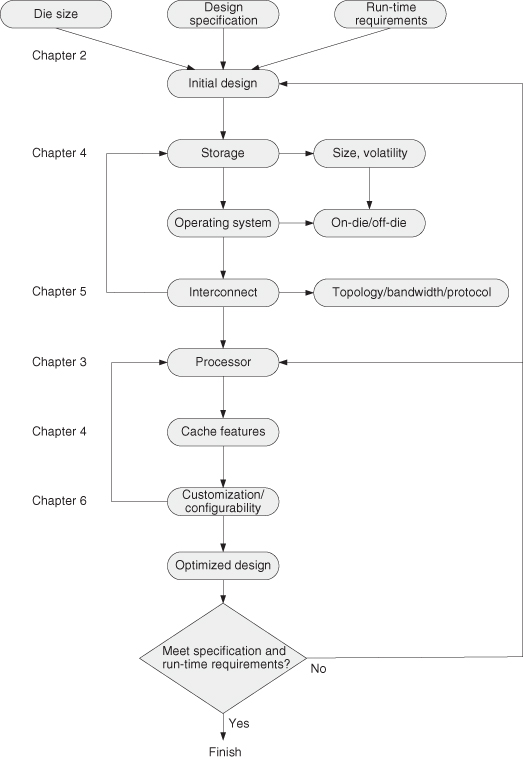PREFACE
The next generation of computer system designers will be concerned more about the elements of a system tailored to particular applications than with the details of processors and memories.
Such designers would have rudimentary knowledge of processors and other elements in the system, but the success of their design would depend on their skills in making system-level trade-offs that optimize the cost, performance, and other attributes to meet application requirements.
This text is organized to introduce issues in computer system design, particularly for system-on-chip (SOC). Managing such design requires knowledge of a number of issues, as shown in Figure 1.
Figure 1 An approach to SOC system design described in this book.

After Chapter 1, the introduction chapter, Chapter 2 looks at issues that define the design space: area, speed, power consumption, and configurability. Chapters 3–5 provide background knowledge of the basic elements in a system: processor, memory, and interconnect.
The succeeding chapters focus on computer systems tailored to specific applications and technologies. Chapter 6 covers issues in customizing and configuring designs. Chapter 7 addresses system-level trade-offs for various applications, bringing together earlier material in this study. Finally, Chapter 8 presents future challenges for system design and SOC possibilities.
The tools that illustrate the material in the text are still being developed. The Appendix provides an overview of one such tool. Since our tools are evolving, please check from time to time to see what is available at the companion web site: www.soctextbook.com.
Moreover, material useful for teaching, such as slides and answers to exercises, is also being prepared.
This book covers a particular approach to computer system design, with emphasis on fundamental ideas and analytical techniques that are applicable to a range of applications and architectures, rather than on specific applications, architectures, languages, and tools. We are aware of complementary treatments on these and also on other topics, such as electronic system-level design, embedded software development, and system-level integration and test. We have included brief descriptions and references to these topics where appropriate; a more detailed treatment can be covered in future editions or in different volumes.
SOC is a quickly developing field. Although we focused on fundamental material, we were forced to draw a line on the inclusion of the latest technological advances for the sake of completing the book. Such advances, instead, are captured as links to relevant sources of information at the companion web site described above.
Many colleagues and students, primarily at Imperial College London and Stanford University, have contributed to this book. We are sorry that we are not able to mention them all by name here. However, a number of individuals deserve special acknowledgment. Peter Cheung worked closely with us from the beginning; his contributions shaped the treatment of many topics, particularly those in Chapter 5. Tobias Becker, Ray Cheung, Rob Dimond, Scott Guo, Shay Ping Seng, David Thomas, Steve Wilton, Alice Yu, and Chi Wai Yu contributed significant material to various chapters. Philip Leong and Roger Woods read the manuscript many times carefully and provided many excellent suggestions for improvement. We also greatly benefited from comments by Jeffrey Arnold, Peter Boehm, Don Bouldin, Geoffrey Brown, Patrick Hung, Sebastian Lopez, Oskar Mencer, Kevin Rudd, and several anonymous reviewers. We thank Kubilay Atasu, Peter Collingbourne, James Huggett, Qiwei Jin, Adrien Le Masle, Pete Sedcole, and Tim Todman, as well as those who prefer to remain anonymous, for their invaluable assistance.
Last, but not least, we thank Cassie Strickland, of Wiley, and Janet Hronek, of Toppan Best-set, for their help in the timely completion of this text.
